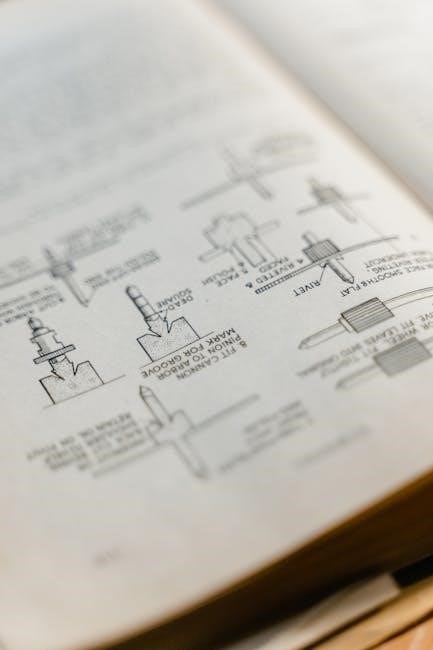
The Illinois Technical Reference Manual is a crucial resource for engineering and construction, providing standardized procedures, material specifications, and design guidelines. It ensures compliance with state regulations, promoting safety and efficiency across projects.
1.1 Overview of the Manual
The Illinois Technical Reference Manual is a comprehensive guide designed to standardize technical procedures, material specifications, and design guidelines for engineering and construction projects. It serves as a foundational document for calculating energy usage, emissions, and capacity savings, ensuring regulatory compliance and transparency. The manual is updated annually to reflect current standards and methodologies, addressing data gaps and promoting consistency across stakeholders. It is widely used by engineers, developers, planners, and government officials involved in land use planning, site development, and natural resource conservation. The manual’s structured approach ensures safety, efficiency, and adherence to state regulations, making it an essential resource for professionals in Illinois.
- Provides standardized methods for energy and emissions calculations.
- Supports land use planning and site development.
- Ensures compliance with state and environmental regulations.
Its annual updates ensure relevance and accuracy, benefiting stakeholders across various sectors.
1.2 Purpose and Scope
The Illinois Technical Reference Manual is designed to provide standardized methodologies for calculating energy usage, emissions, and capacity savings in efficiency programs. Its primary purpose is to ensure consistency, accuracy, and transparency in reporting, while supporting regulatory compliance and addressing data gaps. The manual serves as a foundational resource for stakeholders, including utilities, regulators, and consumers, to standardize approaches and ensure alignment with state regulations. Its scope extends to land use planning, site development, and natural resource conservation, offering guidance for engineers, developers, and government officials. By providing clear guidelines, the manual promotes safety, efficiency, and adherence to environmental standards across Illinois.
- Standardizes energy and emissions calculation methods.
- Supports compliance with state and environmental regulations.
- Facilitates transparency among stakeholders.
It is widely used in engineering, construction, and planning projects to ensure consistency and accuracy.

1.3 Key Features and Benefits
The Illinois Technical Reference Manual offers standardized methods for energy usage and emissions calculations, ensuring consistency and accuracy in reporting. It provides comprehensive design guidelines, material specifications, and best practices for engineering and construction projects. The manual is updated annually to reflect the latest standards and regulations, ensuring stakeholders have access to current information. Its key features include detailed technical specifications, compliance with state and environmental regulations, and tools for efficient implementation. These elements make it an indispensable resource for professionals, promoting safety, efficiency, and transparency in various projects.
- Standardized energy and emissions calculation methods.
- Updated annually to reflect current standards.
- Comprehensive design and material guidelines.
- Supports compliance with environmental regulations.
These features ensure the manual remains a vital tool for engineers, developers, and regulators in Illinois.

Structure of the Illinois Technical Reference Manual
The manual is organized into clear chapters and sections, ensuring easy navigation. It includes detailed appendices and references, making it a user-friendly resource for professionals.
- Divided into numbered chapters for clarity.
- Includes appendices for supplementary information.
- Features cross-references for seamless navigation.
- Regularly updated to maintain relevance.
This structure enhances accessibility and usability for engineers, developers, and regulators.
2.1 Detailed Outline of the Manual
The Illinois Technical Reference Manual is divided into nine primary chapters, each containing specific subsections. Chapter 1 introduces the manual, while Chapters 2-8 cover structure, technical specs, applications, updates, compliance, best practices, and case studies. Chapter 9 concludes with future directions. Each chapter is further subdivided into detailed sections, ensuring comprehensive coverage. The manual includes tables of contents, cross-references, and appendices for supplementary data. This logical organization allows users to easily locate information, making it a valuable tool for engineers, planners, and regulators. The outline is designed to enhance usability, ensuring all topics are accessible and clearly presented.
2.2 Key Chapters and Sections
The Illinois Technical Reference Manual includes several key chapters that form the core of its content. Chapter 3 focuses on Technical Specifications and Standards, providing detailed material requirements and design guidelines. Chapter 4 highlights Applications, emphasizing its use in engineering, energy efficiency, and land planning. Chapter 6 addresses Regulatory Compliance, ensuring alignment with state and environmental standards. Chapter 7 covers Best Practices and Methodologies, offering tools for effective implementation. Additionally, the manual includes appendices with supplementary data and references. These chapters and sections are essential for understanding and applying the manual’s guidelines effectively, making them indispensable for professionals in the field.
2.3 Organization and Navigation
The Illinois Technical Reference Manual is meticulously organized to ensure ease of navigation. The manual is divided into clear, logical chapters, each containing numbered sections and subsections. Headings and subheadings are prominently displayed, while tables, figures, and appendices are cross-referenced for quick access. A detailed table of contents and index facilitate rapid location of specific topics. Visual elements like charts and diagrams further enhance comprehension. The manual’s digital version includes bookmarks and hyperlinks, making it user-friendly. This structured approach ensures that users can efficiently find and utilize the information they need, aligning with the manual’s goal of providing a practical and accessible resource for professionals.

Technical Specifications and Standards
The Illinois Technical Reference Manual outlines essential technical specifications and standards for materials, design criteria, environmental compliance, safety protocols, energy efficiency, and testing protocols to ensure adherence.
3.1 Material Specifications and Requirements
The Illinois Technical Reference Manual provides detailed material specifications and requirements to ensure compliance with state and federal regulations. It outlines standards for construction materials, including concrete, steel, asphalt, and aggregates. The manual specifies testing protocols to verify material quality and performance. Adherence to these requirements ensures structural integrity, safety, and environmental sustainability. It also covers allowable tolerances, certification processes, and documentation needed for compliance. These specifications are essential for engineers, contractors, and architects to ensure materials meet project demands and regulatory expectations. Proper material selection and compliance are critical for successful project execution and long-term durability.
3.2 Design Guidelines and Best Practices
The Illinois Technical Reference Manual offers comprehensive design guidelines and best practices to optimize project outcomes. It emphasizes sustainable design principles, energy efficiency, and accessibility standards. The manual provides standardized procedures for site planning, structural design, and system integration. Best practices include adherence to lifecycle cost analysis, resilience strategies, and stakeholder engagement. These guidelines ensure compliance with regulatory requirements while promoting innovative solutions. They also address environmental considerations, such as stormwater management and green infrastructure. By following these guidelines, professionals can achieve cost-effective, functional, and environmentally responsible designs that meet Illinois’ specific needs and enhance overall project performance.
3.3 Compliance with State Regulations
The Illinois Technical Reference Manual ensures adherence to state regulations through detailed compliance guidelines. It aligns with Illinois’ environmental, safety, and energy codes, providing clear frameworks for regulatory adherence. The manual includes checklists, templates, and verification processes to streamline compliance. It addresses specific state requirements for permits, inspections, and reporting, ensuring projects meet legal standards. Compliance is reinforced through adherence to Illinois-specific laws, reducing the risk of penalties. The manual also provides resources for interpreting complex regulations, making it easier for professionals to ensure their work aligns with state mandates. This section is crucial for maintaining legal and operational integrity in Illinois-based projects.

Applications of the Illinois Technical Reference Manual
The manual is widely applied in engineering, construction, and energy projects, aiding in compliance, efficiency, and sustainable development across Illinois. It supports land use planning and resource management effectively.
4.1 Use in Engineering and Construction Projects
The Illinois Technical Reference Manual serves as a critical resource for engineering and construction projects, providing standardized guidelines for design, materials, and compliance. It ensures adherence to state regulations, promoting safe and reliable infrastructure development. The manual offers detailed specifications for various technical aspects, enabling engineers to make informed decisions. Its best practices facilitate efficient project management, reducing costs and enhancing overall quality. By aligning with current standards, it supports sustainable construction practices and environmental stewardship. This resource is indispensable for professionals seeking to deliver compliant, high-performance projects across Illinois.
4.2 Role in Energy Efficiency and Savings Calculations
The Illinois Technical Reference Manual plays a pivotal role in energy efficiency by providing detailed guidelines for calculating energy usage and savings. It offers standardized formulas and methodologies to assess energy consumption in various systems, enabling accurate predictions of efficiency improvements. The manual supports compliance with energy codes and sustainability goals, helping professionals optimize building performance. Additionally, it includes data on material thermal properties and system efficiencies, which are essential for conducting life-cycle cost analyses. By leveraging these resources, stakeholders can identify cost-effective strategies to reduce energy consumption and operational costs, aligning with Illinois’ broader energy conservation objectives.
4.3 Application in Land Use Planning and Development
The Illinois Technical Reference Manual serves as a valuable resource in land use planning and development by providing guidelines for sustainable and efficient land management. It offers tools and methodologies to assess land suitability, optimize resource allocation, and ensure compliance with zoning and environmental regulations. The manual supports urban planning initiatives by providing data on infrastructure requirements, transportation systems, and green space integration. Additionally, it assists in evaluating the environmental impact of development projects, ensuring alignment with state and local sustainability goals. By integrating technical standards and best practices, the manual helps create balanced and resilient land use strategies that promote economic growth while preserving natural resources.

Updates and Maintenance of the Manual
The Illinois Technical Reference Manual undergoes regular updates to incorporate new technologies and stakeholder feedback, ensuring it remains a reliable and current resource for users.
5.1 Version History and Revisions

The Illinois Technical Reference Manual has undergone several revisions since its inception, with updates typically occurring annually to reflect advancements in technology, regulatory changes, and user feedback. Each version is carefully documented, highlighting modifications to technical specifications, design guidelines, and compliance standards. The revision process involves stakeholder input, ensuring that updates align with industry needs and state requirements. A detailed changelog is provided with each release, allowing users to track updates easily. This systematic approach ensures the manual remains accurate, relevant, and adaptable to evolving challenges in engineering, construction, and energy efficiency. Regular revisions also maintain its credibility as a trusted resource for professionals.
5.2 Process for Updates and Stakeholder Involvement
The Illinois Technical Reference Manual undergoes a structured update process to ensure accuracy and relevance. Updates are initiated by a review committee, which evaluates emerging trends, regulatory changes, and user feedback. Stakeholders, including engineers, contractors, and state agencies, are actively involved through public comment periods and workshops. This collaborative approach ensures that revisions reflect real-world needs and industry advancements. Proposed changes are rigorously reviewed and tested before final approval. The transparent process fosters trust and accountability, making the manual a dynamic and reliable tool for professionals. Stakeholder involvement is crucial for maintaining its practicality and alignment with state priorities. This ensures the manual remains a cornerstone for technical guidance.
5.3 Accessing the Latest Version
The Illinois Technical Reference Manual is readily available online through the official state website. Users can download the latest version in PDF format, ensuring easy access and compatibility across devices. The manual is regularly updated, and its webpage includes a version history to track changes. A dedicated section highlights recent revisions, enabling users to quickly identify updates. Additionally, stakeholders can subscribe to email notifications for new releases. The manual is free to download, promoting widespread accessibility. By providing a user-friendly platform, the state ensures that professionals and stakeholders can easily access the most current guidance and standards. This streamlined process supports compliance and efficient project management.

Regulatory Compliance and Standards
The Illinois Technical Reference Manual ensures adherence to state regulations and environmental standards, guiding users to meet safety protocols and compliance requirements effectively.
6.1 Alignment with Illinois State Regulations
The Illinois Technical Reference Manual is meticulously aligned with Illinois state regulations, ensuring all technical guidelines and standards comply with legal requirements. It incorporates specific codes and statutes relevant to engineering, construction, and environmental practices. The manual addresses design specifications, material standards, and safety protocols mandated by state laws. By adhering to these regulations, the manual streamlines compliance for professionals, reducing legal risks and ensuring projects meet governmental expectations. Regular updates reflect changes in state legislation, maintaining relevance and accuracy. This alignment ensures consistency across projects, fostering a standardized approach to technical practices statewide.
6.2 Adherence to Environmental and Safety Standards
The Illinois Technical Reference Manual emphasizes strict adherence to environmental and safety standards, ensuring projects meet both state and federal regulations. It outlines best practices for minimizing ecological impact, such as reducing emissions and managing waste effectively. Safety protocols are detailed to protect workers and the public, covering equipment operation and hazard mitigation. The manual aligns with EPA guidelines and OSHA standards, providing clear guidelines for compliance. Regular updates incorporate new environmental and safety regulations, ensuring the manual remains a reliable resource for sustainable and safe practices. This focus on environmental stewardship and workplace safety underscores the manual’s commitment to responsible technical execution.
6.3 Reporting Requirements and Documentation
The Illinois Technical Reference Manual outlines specific reporting requirements and documentation standards to ensure transparency and accountability in technical projects. It mandates detailed record-keeping for all phases of project execution, including data collection, compliance checks, and stakeholder communications. Documentation must adhere to state and federal guidelines, ensuring accuracy and accessibility. Regular reporting cycles are specified to monitor progress and address potential issues promptly. Non-compliance with these requirements may result in penalties or project delays. The manual emphasizes the importance of maintaining thorough records for audits, legal purposes, and future reference, ensuring all stakeholders can access critical information efficiently. Proper documentation fosters accountability and ensures adherence to regulatory standards, safeguarding project integrity and public trust.

Best Practices and Methodologies
The Illinois Technical Reference Manual promotes standardized approaches for efficient and compliant project execution, emphasizing proven methodologies to ensure accuracy, safety, and environmental stewardship in technical applications.
7.1 Standardized Methods for Energy Usage Calculation
The Illinois Technical Reference Manual outlines standardized methods for calculating energy usage, ensuring accuracy and consistency across projects. These methods are designed to align with industry best practices and state regulations. Detailed formulas and procedures are provided for determining energy consumption in various systems, including HVAC, lighting, and insulation. The manual emphasizes the importance of accurate data input and offers guidelines for conducting energy audits and simulations. By following these standardized approaches, professionals can make informed decisions, optimize energy efficiency, and ensure compliance with relevant codes and standards. These methods also support broader goals of reducing energy consumption and carbon emissions in Illinois.
7.2 Emissions Reporting and Management
The Illinois Technical Reference Manual provides comprehensive guidance on emissions reporting and management, ensuring compliance with state and federal environmental regulations. It outlines detailed methodologies for quantifying greenhouse gas emissions and other pollutants from various sources, such as industrial processes and energy systems. The manual includes standardized protocols for data collection, emission factor application, and reporting formats. Additionally, it offers tools and resources to help organizations track and reduce their emissions effectively. By adhering to these guidelines, stakeholders can ensure transparency, accuracy, and compliance in their emissions reporting. This section also emphasizes the importance of aligning with broader environmental goals and reducing Illinois’ carbon footprint.
7.3 Tools and Resources for Effective Implementation
The Illinois Technical Reference Manual provides a variety of tools and resources to support effective implementation of its guidelines. These include software tools for energy modeling, emission calculators, and compliance checklists. Additionally, the manual offers detailed templates for reporting and documentation, ensuring consistency and accuracy. Users can access webinars, training materials, and case studies to enhance their understanding. The manual also includes links to external databases and regulatory resources, streamlining the process of staying updated on requirements. These tools and resources empower professionals to apply the manual’s standards efficiently, ensuring projects meet technical and regulatory expectations while promoting best practices in implementation.

Case Studies and Practical Applications
The manual highlights real-world projects in Illinois, showcasing effective implementation of its guidelines in infrastructure, energy, and land development, demonstrating practical benefits and lessons learned.
8.1 Successful Projects Utilizing the Manual
The Illinois Technical Reference Manual has been instrumental in several high-profile projects across the state. One notable example is the development of a LEED-certified commercial building in Chicago, where the manual’s energy efficiency guidelines helped reduce operational costs by 30%. Another success story involves a renewable energy farm in central Illinois, which utilized the manual’s design specifications to optimize wind turbine placement and performance. Additionally, a transportation infrastructure project in Springfield applied the manual’s material standards, ensuring durability and compliance with state regulations. These projects highlight the manual’s practical application and its role in driving sustainable and efficient outcomes.
8.2 Lessons Learned and Real-World Examples
Implementation of the Illinois Technical Reference Manual has yielded valuable insights. A key lesson is the importance of adhering to standardized guidelines to ensure consistency and compliance. For instance, a municipal water treatment project in southern Illinois faced initial delays due to deviations from the manual’s specifications but achieved efficiency gains after realigning with its recommendations. Additionally, stakeholders have emphasized the need for clear communication and collaboration during the planning phase. These real-world examples underscore the manual’s role in mitigating risks and enhancing project outcomes, while also highlighting areas for potential improvements in future updates.
8.3 Impact on Efficiency and Compliance
The Illinois Technical Reference Manual has significantly enhanced efficiency and compliance across various projects. By providing standardized guidelines, it reduces errors and delays, ensuring projects align with state and national standards. Compliance is streamlined through adherence to predefined specifications, minimizing legal and regulatory risks. For example, energy-efficient building projects have reported cost reductions of up to 15% due to optimized designs. Additionally, the manual’s clear frameworks facilitate quicker approvals and inspections, accelerating project timelines. Its emphasis on sustainability has also promoted environmentally friendly practices, contributing to long-term efficiency gains. Overall, the manual serves as a cornerstone for balancing compliance with operational excellence.
The Illinois Technical Reference Manual is a vital resource for standardized practices and compliance. Future updates will focus on emerging technologies and stakeholder feedback to ensure continued relevance and effectiveness.
9.1 Importance of the Illinois Technical Reference Manual
The Illinois Technical Reference Manual serves as a central resource for standardized practices and compliance, ensuring consistency across engineering, construction, and planning projects. By providing detailed specifications and guidelines, it streamlines processes, reducing errors and enhancing efficiency. Professionals rely on the manual to align with state regulations, environmental standards, and safety protocols, fostering trust and accountability. Its comprehensive approach supports cost-effective solutions and sustainable practices, making it indispensable for modern projects. The manual’s importance lies in its ability to adapt to industry changes while maintaining rigorous standards, ensuring Illinois remains at the forefront of technical innovation and responsible development.
9.2 Future Updates and Evolution of the Manual
The Illinois Technical Reference Manual will continue to evolve to address emerging technologies and regulatory changes. Future updates will focus on incorporating new energy-efficient practices, advanced materials, and digital tools to enhance user accessibility. The manual will expand its scope to cover innovative construction methods and sustainable development strategies, ensuring alignment with global environmental standards. Regular revisions will be informed by stakeholder feedback, industry advancements, and legislative updates. This ongoing improvement ensures the manual remains a vital resource for professionals, supporting Illinois’s commitment to progress and sustainability while maintaining its role as a cornerstone of technical excellence and compliance.